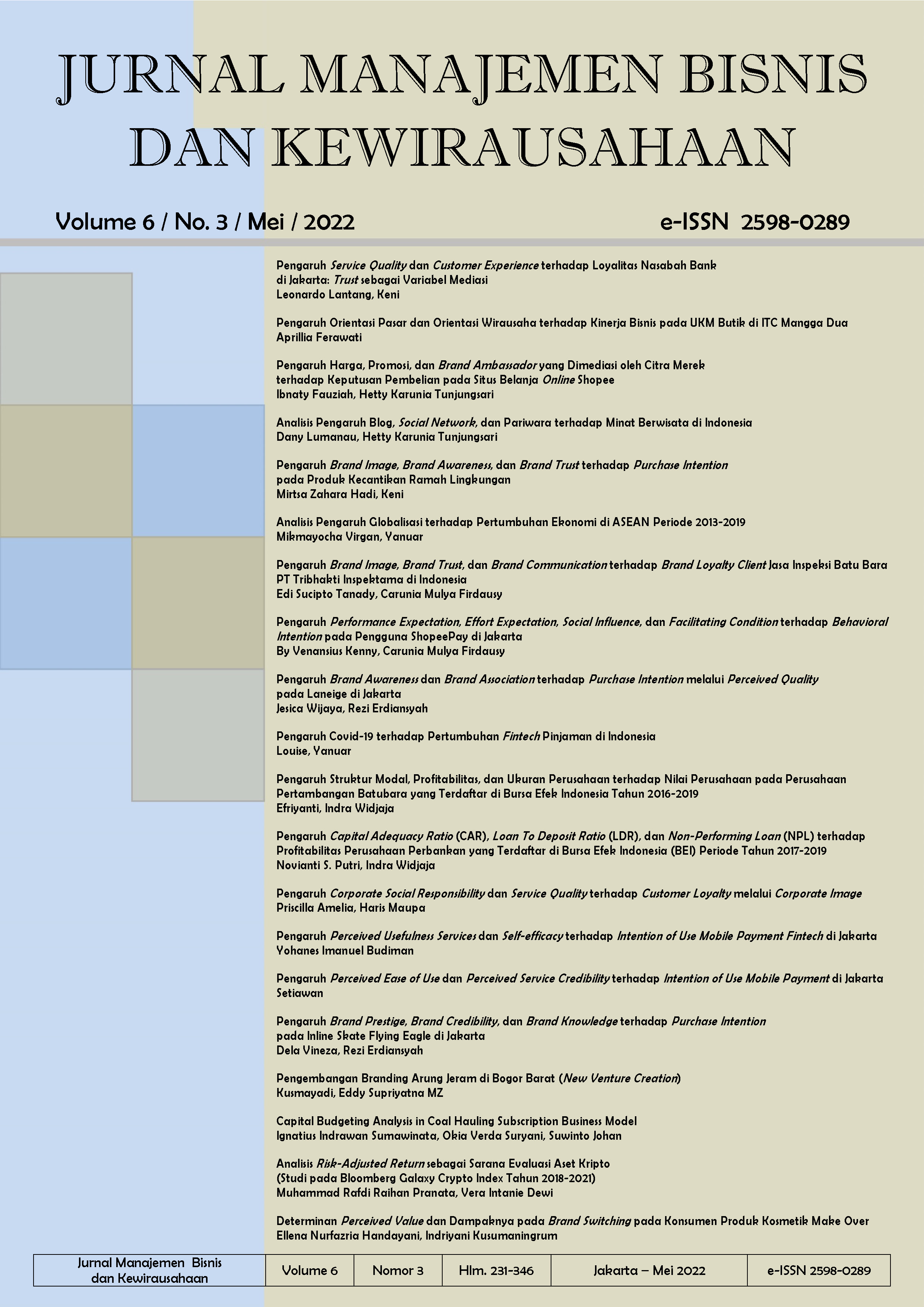Pengaruh Performance Expectation, Effort Expectation, Social Influence, dan Facilitating Condition terhadap Behavioral Intention pada Pengguna ShopeePay di Jakarta
Main Article Content
Abstract
The behavioral intention of e-wallet users has increased significantly today. This study aims to analyze the influence of performance expectation, effort expectation, social influence, and facilitating conditions on the behavioral intention of ShopeePay users in Jakarta. Methods used to collect the data were by distributing questionnaires as an instrument to one hundred respondents who did their transactions by using ShopeePay in Jakarta. The data was then analyzed by applying the Partial Least Squares (PLS) statistical method. The result showed that the behavioral intention of users who used ShopeePay was influenced by performance expectation, effort expectation, social influence, and facilitating conditions. Therefore, the ShopeePay company needs to pay attention to these four variables to improve the behavioral intention of its users.
Behavioral intention dari pengguna dompet digital telah meningkat secara signifikan saat ini. Penelitian ini bertujuan untuk menganalisis pengaruh performance expectation, effort expectation, social influence, dan facilitating condition terhadap behavioral intention pengguna ShopeePay di Jakarta. Metode yang digunakan untuk mengumpulkan data adalah dengan menyebarkan kuesioner sebagai instrumen kepada seratus responden yang melakukan transaksi dengan menggunakan ShopeePay di Jakarta. Data tersebut kemudian dianalisis dengan menggunakan metode statistik Partial Least Squares (PLS). Hasil penelitian menunjukkan bahwa behavioral intention pengguna yang menggunakan ShopeePay dipengaruhi oleh performance expectation, effort expectation, social influence, dan facilitating condition. Oleh karena itu, perusahaan ShopeePay perlu memperhatikan keempat variabel ini untuk meningkatkan behavioral intention penggunanya.
Article Details
This work is licensed under a Jurnal Manajemen Bisnis dan Kewirausahaan Creative Commons Attribution-ShareAlike 4.0 International License.
References
Bank Indonesia. (2020). Jumlah uang elektronik beredar. https://www.bi.go.id/id/statistik/ekonomi-keuangan/spip/Documents/TABEL_5e.pdf
Ghalandari, K. (2012). The effect of e-service quality on e-trust and e-satisfaction as key factors influencing creation of e-loyalty in e-business context: The moderating role of situational factors. Journal of Basic and Applied Scientific Research, 2(12), 12847–12855. https://www.textroad.com/pdf/JBASR/J. Basic. Appl. Sci. Res., 2(12)12847-12855, 2012.pdf
Ghozali, I. (2020). 25 grand theory - 25 teori besar ilmu manajemen, akuntansi dan bisnis (Untuk landasarn teori skripsi, tesis dan disertasi). Yoga Pratama.
Gupta, K. P., Manrai, R., & Goel, U. (2019). Factors influencing adoption of payments banks by Indian customers: Extending UTAUT with perceived credibility. Journal of Asia Business Studies, 13(2), 173–195. https://doi.org/10.1108/JABS-07-2017-0111
Hair, Jr., J. F., Hult, G. T. M., Ringle, C. M., & Sarstedt, M. (2016). A primer on partial least squares structural equation modeling (PLS-SEM) (2nd ed.). SAGE.
Madan, K., & Yadav, R. (2016). Behavioural intention to adopt mobile wallet: A developing country perspective. Journal of Indian Business Research, 8(3), 227–244. https://doi.org/10.1108/JIBR-10-2015-0112
Mansoori, K. A. Al, Sarabdeen, J., & Tchantchane, A. L. (2018). Investigating Emirati citizens’ adoption of e-government services in Abu Dhabi using modified UTAUT model. Information Technology and People, 31(2), 455–481. https://doi.org/10.1108/ITP-12-2016-0290
McKeown, T., & Anderson, M. (2016). UTAUT: capturing differences in undergraduate versus postgraduate learning? Education and Training, 58(9), 945–965. https://doi.org/10.1108/ET-07-2015-0058
Mowen, J. C., & Minor, M. (2002). Perilaku konsumen (D. K. Yahya (trans.); 5th ed., Vol. 2). Erlangga.
Nugroho, K. W., & Habibi, I. (2013). Melejitnya pengguna digital wallet di masa pandemi. KumparanBISNIS. https://kumparan.com/kumparanbisnis/melejitnya-pengguna-digital-wallet-di-masa-pandemi-1vNFqjo24Dl/full
Qasim, H., & Abu-Shanab, E. (2016). Drivers of mobile payment acceptance: The impact of network externalities. Information Systems Frontiers, 18(5), 1021–1034. https://doi.org/10.1007/s10796-015-9598-6
Rahi, S., Othman Mansour, M. M., Alghizzawi, M., & Alnaser, F. M. (2019). Integration of UTAUT model in internet banking adoption context: The mediating role of performance expectancy and effort expectancy. Journal of Research in Interactive Marketing, 13(3), 411–435. https://doi.org/10.1108/JRIM-02-2018-0032
Tai, Y. M., & Ku, Y. C. (2013). Will stock investors use mobile stock trading? A benefit-risk assessment based on a modified utaut model. Journal of Electronic Commerce Research, 14(1), 67–84.
Venkatesh, V., & Davis, F. D. (2000). Theoretical extension of the Technology Acceptance Model: Four longitudinal field studies. Management Science, 46(2), 186–204. https://doi.org/10.1287/mnsc.46.2.186.11926
Venkatesh, V., Morris, M. G., Davis, G. B., & Davis, F. D. (2003). User acceptance of information technology: Toward a unified view. MIS Quarterly: Management Information Systems, 27(3), 425–478. https://doi.org/10.2307/30036540


